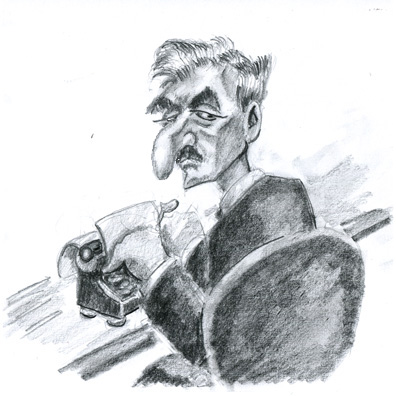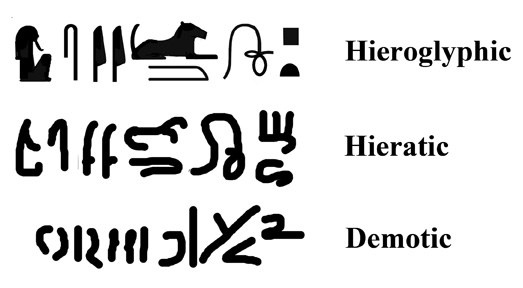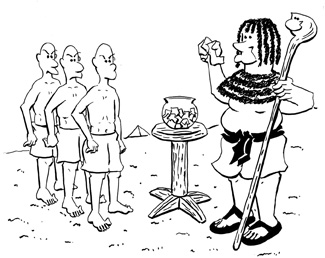William Faulkner
And His Greatest Work

William Faulkner
It was
Land of the Pharaohs.
- "I don't know how pharaohs talked. And Faulkner didn't know."
- Howard Hawks
In the 1940's and 1950's Hollywood was trying to beef up its image. In an era when television was rare or non-existant, it was Tinsel Town that was getting the reputation for mentoring dunderheads and creating its own vast wasteland of misinformation.
So what do you do if you nevertheless want to produce a cheesy, swords-and-sandals extravaganza complete with scantily clad slave girls and foreign princesses accompanied by strutting beefcake actors so you can tell the story about when King Khufu was building his Great Pyramid he ends up impoverishing the whole country and empire?
Why, you just call in a recent Nobel Prize Winner in Literature and slap his name on the screenplay. That adds an intellectual air to the movie. And at the time the most famous recent Nobel Prize Winner was William Faulkner.
Of course, there were two other screenwriters credited for the script: Harry Kurnitz and Harold Bloom. Both were experienced Hollywood writers with good track records.
Now we're not saying that Harry and Harold did the real writing while Bill (as he was called) just went along for the prestige. Heaven forfend! Howard Hawk, the producer and director, confirmed that Bill did indeed work on the script.
Bill, though, did say that his contributions were mostly writing down synopses or outlines of the scenes. He felt that the details of the action and dialog would be best decided once everyone got on the set. Nevertheless the tripartite billing was perfectly proper.
And just what was this story about - a story that we can and will say is William Faulkner's greatest work?
The movie - Land of the Pharaohs - was a flop. Produced and directed by Howard Hawks, it was filmed in Egypt with (reportedly) as many as 10,000 extras. The production costs were a whopping $3,000,000 (big money back then) and the film missed breaking even by at least a couple of hundred grand. The critics also skewered it although today, seeing the effort that went into the production, viewers tend to be a bit more generous.

Hieroglyphic, Hieratic, and Demotic
Writing in Ancient Egypt
We hear the story from the voiceover of Hamar, the Lord High Priest of Egypt to Khufu and the Pharaoh's boon companion and boyhood friend. We see him writing the story down on a papyrus. He uses the hieroglyphic script although in writing stories on papyrus, the Egyptians used a cursive version called hieratic and in later centuries an even more abbreviated script called demotic.
The Great Egyptian Pharaoh Khufu ( in Ancient Egyptian Hieroglyphics*) and known to some by his Greek moniker Cheops (Χέοψ and pronounced "KHEE-ops") has returned from waging war against vaguely described "enemies of Egypt". Affably played by British actor Jack Hawkins, the Pharaoh now has so much plunder, riches, and slaves that he decides to build a massive pyramidal tomb so he can take it with him.
in Ancient Egyptian Hieroglyphics*) and known to some by his Greek moniker Cheops (Χέοψ and pronounced "KHEE-ops") has returned from waging war against vaguely described "enemies of Egypt". Affably played by British actor Jack Hawkins, the Pharaoh now has so much plunder, riches, and slaves that he decides to build a massive pyramidal tomb so he can take it with him.
Footnote
The cognoscenti say that the proper word is "Hieroglyphs", and not (ptui) "Hieroglyphics". But the other two Ancient Egyptian scripts are called "Hieratic"and "Demotic" without censure. In fact using an adjective - "Hieroglyphic" for a "Hieroglyphic character" (and hence in the plural "Hieroglyphics") is a perfectly acceptable grammatical feature of standard English.
Of course, at that time - the Third Dynasty or around 2700 BCE - Egypt had not yet gotten to where it was establishing an Empire. But it is true that Khufu did decide to build a whopping big pyramid as his tomb.
In the movie, Khufu returns to lovingly greet his Queen Nailla (Miriam Charrière, known by the stage name Kerima and wife of Goldfinger director Guy Hamilton). He tells her that he has to get a bath before they do anything more. Nailla is willing to wait until he's well scrubbed.
But Khufu doesn't want to wait to build that pyramid. To help him out he calls in a Kushite architect, a fellow named Vashtar (played by James Robertson Justice). The land of Kush is what we now call Sudan. Vashtar was captured when Khufu was conquering the Kushites although again William and the other screenwriters were being pretty flexible with the history. During Khufu's reign Kush had not been conquered by the Egyptians who pretty much stuck with staying either in the Nile Valley and the Delta.
As the pyramid project moves along, there's yet another historical faux pas. Although there's recent controversy regarding the race of the Ancient Egyptians (as if there was one race - whatever that means - in an area which was a multi-epochian migration route between three continents) there's no doubt that the Kushites were of a sub-Saharan gene pool. One of their characteristics was that they had statistically significantly denser melanocyte composition than most European or American film producers. Ergo, the Kushites were black.
But Vashtar and his son, Senta, (played by Dewey Martin) are about as white as you can get (again making allowances for what Hollywood make-up departments consider to be a goodly tan). About all we can say was the script fit with the idea of some of the more conservative of 19th and early 20th century Egyptologists who couldn't believe that the civilization they uncovered in the Sudan was an independent and advanced black kingdom. Besides having Vashtar looking like Socrates would probably sell more tickets.
But whatever Vashtar's background, the problems of making the tomb are incredible and Vashtar has to figure it all out. But for some reason, Khufu seems to have forgotten that his dad, the Pharaoh Sneferu, had already built a pyramid. Called the Red Pyramid, Sneferu's tomb is actually higher than the Great Pyramid of Mycerinus and is about 12 miles away.
Once Vashtar has the logistics all figured out, Khufu has the entire country brought in to help. Originally doing so cheerfully, after a while the workers begin grumbling because Khufu is spending so much money he has to raise the taxes and impoverish the country.
Again we have a bit of real history and yet a bit of stretching. The Egyptian workers who built the pyramids were probably not slaves, or at least most of them weren't. But they probably were what is known as corvée labor. This sounds better than "forced labor" which is what it is.

The Labor Force
Exactly who was chosen and how isn't clear. Probably each town had a quota of workers to send. There could have been volunteers or the mayors could have picked out who was to go. The choice could also have been by lottery.
But in any case, in the movie we saw thousands of workers quarrying and hauling the blocks. Even if you haven't seen the movie, you may have seen some of the scenes as they have been borrowed for some of the more low-budget documentaries about Ancient Egypt.
Of course, building the Great Pyramid takes time and after years of work, Khufu had pretty much run out of money. Or he's run out of money in Egypt. So he started ordering the conquered lands to send him tribute. But the Princess of Cypress, a hot-babe named Nellifer (Joan Collins wearing exotic but unconvincing dark pancake makeup), shows up and says her country doesn't have any money. But she at least has - well, "something" to offer and to spare.
So to make everything aboveboard Khufu takes Nellifer as his (second) wife. Naturally having to share her husband with Nellifer doesn't please Queen Nailla. But pharaohs having multiple wives was pretty much par for the course, and there wasn't much Nailla could do about it.
To complicate matters, Nellifer notes that the Captain of the Guard is a hefty hunk named Treneh (played by Sydney Chaplin, the son of Charlie Chaplin). She invites him in for a drink and they start getting it on.
Through all this Nailla remains the true Queen. So her son, Prince Zanin, is first in line for the throne.
Nellifer realizes that as a "secondary" wife, any of her offspring can't be pharaoh. But they could be if somehow Zanin was gotten rid of. Better yet, she thought, if Zanin, Nailla, and Khufu are all dispatched, she can become a Lady Pharaoh herself, run the country, and still keep making whoopee with Treneh.
So Nellifer has a cobra trained to respond to music even though cobras, like all snakes, are deaf to sound transmitted through the air. And as young Zanin plays a flute (a gift, of course, of Nellifer), the cobra comes in and gets ready to strike. Just then Nailla walks in, and seeing the snake, she throws herself between her son and the cobra. The cobra bites her and she dies, leaving Nellifer as the one-and-only Great Royal Wife.
By this time the pyramid is close to being finished. So Nellifer works out a deal with Treneh to kill Khufu. Treneh then sends a servant named Nabuna to stab Khufu while he's out about the countryside. But Nabuna botches the job and only wounds the King and is himself killed.
Now suspecting that Nellifer may be behind all the strange goings on, Khufu goes back to the palace with his wound dripping blood all the way. He hides behind a pillar where he overhears Treneh and Nellifer talking. But he doesn't hear enough that spills the beans.
Then when Nellifer looks toward the column where Khufu is hiding, she sees the blood spots on the floor. Realizing her plan has gone awry, to save herself she starts yelling at Treneh as if she had just learned that all the bad things going on were his doing. She indignantly says that Treneh will answer to the Pharaoh when he gets there.
But he is there! Khufu jumps out and challenges Treneh to a fight. Eventually Khufu kills Treneh by tossing his sword like a spear. But during the mêlée, Khufu himself has been mortally wounded. Still he lives long enough for Nellifer to sneerily confess she was the real culprit.
After Khufu is laid in his tomb, Nellifer now knows that she will be the ruler of Egypt. But she didn't know that Hamar managed to have huge stones put in place so they would slide down and block the way out while she's still in the tomb. As the film ends, Nellifer is now trapped inside the pyramid - forever.
Now doesn't this beat Light in August?
References
William Faulkner: His Life and Work, David Minter, Johns Hopkins University Press, 1980, 1997.
"Land of the Pharaohs", Variety, December 31, 1954.
"Land of the Pharaohs", Turner Classic Movies.
"Why Faulkner, Fitzgerald and Other Literary Luminaries Hated Hollywood", Christopher Karr, Highbrow Magazine, August 13, 2012.
Some Time in the Sun, Tom Dardis, Hal Leonard Corporation, 1988
Reel History: The World According to the Movies, Alex von Tunzelmann, Atlantic Books, 2015.
"Land of the Pharaohs", Jack Hawkins (actor), Joan Collins (actor), Howard Hawks (director), William Faulkner (writer), Harry Kurnitz (writer), Harold Jack Bloom (writer), Dimitri Tiomkin (composer), Howard Hawks (producer), Warner Brothers, 1955, Internet Movie Data Base.
"Screen: Ancient Story; 'Land of the Pharaohs' Is Standard Saga", A. H. Weiler, The New York Times, July 27, 1955.